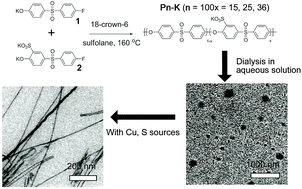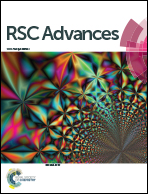Synthesis and self-assembly of partially sulfonated poly(arylene ether sulfone)s and their role in the formation of Cu2S nanowires†
Abstract
Partially sulfonated amphiphilic poly(arylene ether sulfone)s (PSPAESs) were synthesized by one-step nucleophilic aromatic substitution copolymerization. A 4-fluoro-4′-hydroxydiphenyl sulfone potassium salt was used as a hydrophobic monomer, and 5-((4-fluorophenyl)sulfonyl)-2-hydroxybenzenesulfonic acid as a hydrophilic monomer bearing a sulfonic acid group was synthesized from the hydrophobic monomer via selective sulfonation. 1H and 13C nuclear magnetic resonance spectroscopy analysis of PSPAESs indicated formation of statistical amphiphilic copolymers with control over the degree of sulfonation by varying the feed. Dynamic light scattering and transmission electron microscopy analysis indicated that PSPAESs self-assembled into spherical micelles in aqueous solutions. Interestingly, the micellar solution of PSPAESs prepared by dialysis was found to grow Cu2S nanowires on a Cu grid under ambient conditions. Formation of Cu2S nanowires on various substrates including a Si wafer and graphene was demonstrated in the presence of Cu and a sulfur source. UV-vis spectroscopy and X-ray photoelectron spectroscopy data suggests PSPAESs assist dissolution of metallic Cu into Cu(II) enabling the formation of Cu2S nanowires.



 Please wait while we load your content...
Please wait while we load your content...